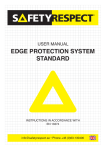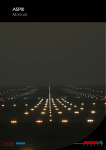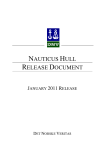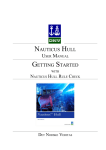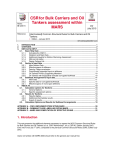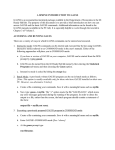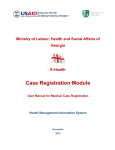Download EDGE PROTECTION SYSTEM HALL BUILDINGS
Transcript
USER’S MANUAL EDGE PROTECTION SYSTEM HALL BUILDINGS BUILDINGS OF STEEL, WOOD AND CONCRETE SAFETYRESPECT AB • Box 69, 831 21 Östersund, Sweden • Phone +46 (0)63-130400 • [email protected] • www.safetyrespect.se 2 GENERAL SafetyRespect’s edge protection system for halls (industrial halls, sports halls, business premises) is used as edge protection on arched roofs, flat roofs or roofs with slight inclination. It is also used in constructions that involve long bearing distances between attachment points for the edge protection and the barriers. The system can be mounted onto different materials such as steel, concrete or glued laminated timber. It is important that the required extension loads are within specifications. The anchor points to the hall system are mounted on walls or post/ beams. Please see the chapter on attachment in the manual. The edge protection can be adjusted/swivelled variably in a simple operation up to 1,000 mm. This means that maximum edge protection can be established both when working on the roof (with the swivel bracket in its “zero” position) and also be swivelled outwards to make possible mounting of gutters or similar work at the façade of the eaves. The flexibility in both height and sideways makes it possible to find solutions that traditional edge protections do not offer. The barriers of aluminium are attached on post with the railing lock and are continuously jointed with pipe joints. SAFETYRESPECT AB • Box 69, 831 21 Östersund, Sweden • Phone +46 (0)63-130400 • [email protected] • www.safetyrespect.se 3 SAFETY PRECAUTIONS Risks when mounting and using • • • • • • Falling Dropping of tools Dropping of components Crushing Injuries to eyes and ears Overload to the edge protection system Measures Always use personal edge protection when carrying out mounting work. 1. Follow the instructions. 2. When mounting or dismounting, personal edge protection shall always be used if there is a risk of falling. This also applies when working from a claw crane, aerial platform, etc. 3. We recommend using a painter connected to tools. 4. Cordon off the area below and around the place of mounting so that unauthorised people cannot be injured in case of dropping, for instance, tools or material. 5. Always use tools, clothing and protective equipment dedicated for the purpose. 6. Always check the products and the equipment before use. 7. Do not use damaged material as it may influence the safety. 8. Tighten and check bolts and bolt connections well. 9. Do not exceed prescribed maximum loads. 10. Do not combine the edge protection system with other products than those recommended by SafetyRespect. Post-accident inspection In case the edge protection system should be subjected to an accident or too high load, this should be inspected by a competent person. Look for deformations of parts included, for example, beams, joints, around holes and bolts. Please contact SafetyRespect if you have any inquiries. Wind, Ice, Snow If the edge protection is made denser by using fabric, plastic, wood structures or similar, the load caused by wind will increase. Never change these conditions without obtaining permission from SafetyRespect. Remove snow and ice from the edge protection system as these may increase the load on the system. Conditions for use • • • • The largest allowable distance between the posts is 6 metres. Correct mounting of attachments and included parts. Make certain that all bolts, nuts and connections are properly tightened. If the situation requires, it may be necessary to use extra anchoring such as storm belts. Notice! For further questions about products or if uncertainty exists regarding mounting please contact SafetyRespect authorized personnel. VERSION 111125 SafetyRespect reserves the right for technical changes. Ensure that you have the latest version of the user manual. SAFETYRESPECT AB • Box 69, 831 21 Östersund, Sweden • Phone +46 (0)63-130400 • [email protected] • www.safetyrespect.se 4 TECHNICAL DATA No. Art. No. Description 1 914154 Plate - centre 140 x 140 2 914155 Plate - side 140 x 140 3 914141 Plate 140 x 140 4 914148 Hex nut 20 5 914145 Rod 20 6 914142 Coupler w. Bracket 7 914146 Wing nut 20 8 914134 Locking socket 20 9 911117 Post 2.0 ALU 10 914115 Swing 11 911110 Post 1.3 12 914143 Stop ring 13 914152 Pin joint 200 mm 14 910113 Aluminium barrier 3 m 15 914560 Flex beam 50 600 16 914121 Flex post bracket 1 3 2 4 5 6 7 8 9 10 11 12 13 14 15 16 SAFETYRESPECT AB • Box 69, 831 21 Östersund, Sweden • Phone +46 (0)63-130400 • [email protected] • www.safetyrespect.se 5 MOUNTING WITH SWING Aluminium barrier 3 m Post 1.3 Recommended max extension loads for attachments using rod is: 15 kN. MOUNTING WITH POST 2.0 ALU Coupler w. bracket & 2 pcs locking socket 20 400 <1000 Swing Post 2.0 ALU Aluminium barrier 3 m 2 pcs Coupler w. bracket Recommended max extension loads for attachments using rod is: 9,5 kN. 400 <235 Coupler w. bracket & 2 pcs locking socket 20 SAFETYRESPECT AB • Box 69, 831 21 Östersund, Sweden • Phone +46 (0)63-130400 • [email protected] • www.safetyrespect.se 6 ATTACHMENTS Depending on the type of beam and post, the attachment requirements differ. The maximum distance between the workspace and Upper Rod 20 is 1 metre at an attachment of c/c 400 mm. At an attachment of c/c 600 mm the maximum distance to the workspace is decreased to 800 mm. The attachment should withstand at least 7.6 kN in extended load. Make sure that the foundation is sufficiently strong. Max avstånd till arbetsyta 1000 mm to Max avstånd till arbetsyta 1000 mm Maximum distance the Max afstand til arbejdsareal 100010 m Max afstand til arbejdsareal workspace 1.000 mm Min 400 Minimum Minc/c 400 c/c B When positioning the attachments, be careful to select an alternative that meets the requirements of the current attachment, and also consider Minbarrier 400 whether the needs Minc/c 400 c/cto be raised to a higher position during work later on. B 400 c/c A A A B ALTERNATIVE ATTACHMENTS The attachments should be made at the centre (A) or on the side of a beam (B), between two adjacent posts (C), straight into a wooden beam (D) or with an imbedded socket. The attachments used can be bolted if they are to be removed later on, or be welded as permanent attachments for future maintenance of the roof and façade. >100 C D SAFETYRESPECT AB • Box 69, 831 21 Östersund, Sweden • Phone +46 (0)63-130400 • [email protected] • www.safetyrespect.se B A 7 MOUNTING Mounting of SafetyRespect’s edge protection system should be carried out under the guidance of a competent person who has studied and understood the mounting instructions and the manual provided by SafetyRespect. A B A. Mount the attachment plate or socket in a wall or a beam. Tighten Rod 20 to the attachment plate (or to the socket). B. Mount the coupler w, bracket to the rod with a locking socket and a wing nut. C. Lock the stop ring on the swing at a position so that both coupler w, bracket can be fastened below. Mount swing to the coupler w, bracket. D. Mount Post 1.3 to the Swing. Turn the post at least half a turn to activate the post lock. C The edge protection can be adjusted/swivelled variably in a simple operation up to 1,000 mm. This means that maximum edge protection can be established both when working on the roof (with the swivel 360 degrees bracket in its “zero” position) and also be swivelled outwards to make possible mounting of gutters or similar work at the façade of the eaves. ALTERNATIVE MOUNTING Alternative mounting in, for example, a scantling is made using beam 600 and (A-D) posts brackets. SAFETYRESPECT AB • Box 69, 831 21 Östersund, Sweden • Phone +46 (0)63-130400 • [email protected] • www.safetyrespect.se D 8 MOUNTING OF BARRIERS OK! 1 2 NOT OK! 3 E. Place the AL barriers on the brackets of the post and lock them in a vertical position. The lower edge of the barrier should be in contact with the underlying support. F G F F. Connect the AL barriers by using pipe joints. F. When sections that can be opened are required, the AL barriers are mounted overlapping with double couplers. G. The corners are jointed with double couplers or Safety Straps. The corners should be attached to at least 2 posts. DISMOUNTING H. Dismounting should be done in the reverse order! SAFETYRESPECT AB • Box 69, 831 21 Östersund, Sweden • Phone +46 (0)63-130400 • [email protected] • www.safetyrespect.se 9 INSPECTION, MAINTENANCE AND STORAGE After use an inspection should always be carried out by a competent person before the products are put into storage. SafetyRespect recommends that a person who has undergone training carry out this inspection. Check that: Control • The parts match as they should • That no deformations can be found Not OK! OK! Storage • That no cracks can be found • That no alterations have been made to the products Renovation • That no rust can be found Storage • That no other external influences can be found Clean the parts when required. Discard Sorted out products can be renovated if it is possible to restore them to perfect condition. Renovation should be carried out by a competent person, suitably someone who has undergone training by SafetyRespect. Only cold working should be carried out on properly cleaned parts. Damaged parts that cannot be renovated should be replaced. Products that are deemed not to be in perfect condition or not possible to restore to perfect condition should be discarded. Products made of steel may be discarded as steel as a whole. Certain products may need to be separately sorted out. When uncertain, please ask SafetyRespect or a person who has undergone training by SafetyRespect for advice. Store SafetyRespect’s products in a dry and well-ventilated space protected against the wheather, corrosive matters and other external influences. SAFETYRESPECT AB • Box 69, 831 21 Östersund, Sweden • Phone +46 (0)63-130400 • [email protected] • www.safetyrespect.se SAFETY CHECK OF EDGE PROTECTION HALL SYSTEM WORKPLACE DATE LOCATION ORDER NO. SITE MANAGER CHECK NO. SITE/PART OF BUILDING 1: 3: 2: 4: CHECK POINTS JA NEJ REF. Are the components damaged? page 7 Are all brackets properly attached? page 5 Does the foundation of the attachments withstand the specified loads? page 5 Is the distance between the attachments and the workspace in accordance with the recommendations? page 4-6 Are all bolts, nuts and similar parts properly tightened? page 4 Are the posts correctly mounted and locked in the brackets so that the post locks are activated? page 6 Is the barriers correctly mounted on the correct side of the post? page 6 Does the lower edge of the barriers contact the surface beneath it? page 6 Are the joints between the barriers correctly carried out? page 6 Is the barriers/link bars correctly locked to the railing lock? page 6 Corner mounting: Is each barriers fastened to two post? page 6 REMARKS CHECKING IN ACCORDANCE WITH THE ABOVE LIST CARRIED OUT BY: DATE SIGNATURE SAFETYRESPECT AB • Box 69, 831 21 Östersund, Sweden • Phone +46 (0)63-130400 • [email protected] • www.safetyrespect.se 11 11 25 10










